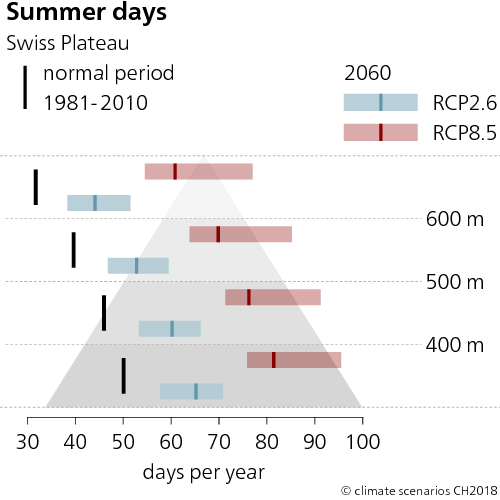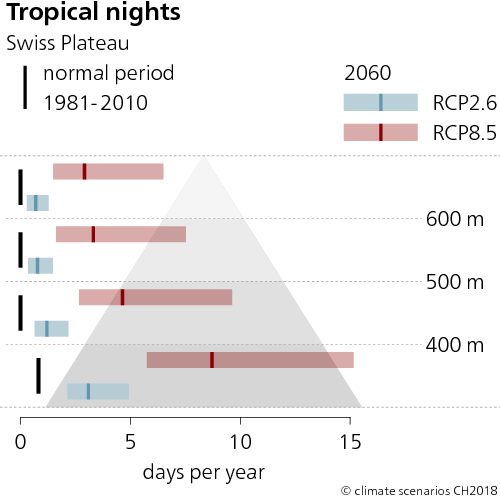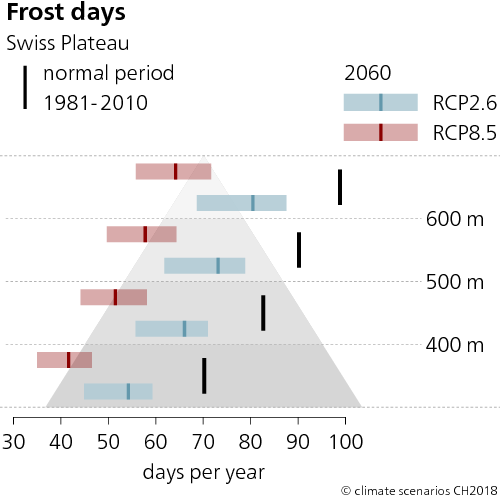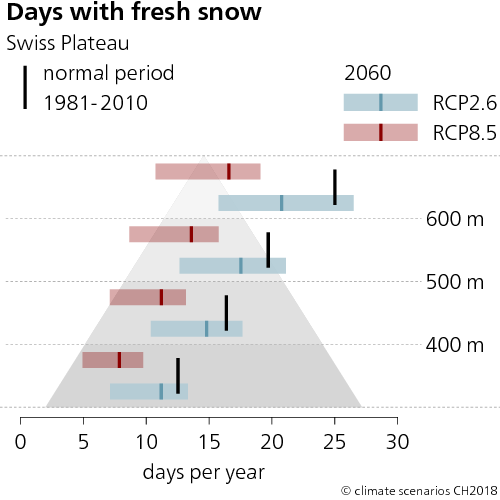The large cities on the Swiss Plateau are situated below 600 m above sea level. It is these locations that will have to reckon with the biggest increases in the number of summer days and tropical nights if climate change mitigation measures are not taken. At the same time, the number of frost days will decrease by around 30 days at all elevations. Currently, there are on average around 25 days of fresh snowfall per year above 600 m a.s.l. It is possible that there will be fewer than 10 by the middle of this century.
The figures below illustrate the changes in four climate parameters at four elevations on the Swiss Plateau. The elevations are shown in the right-hand half of the charts. The vertical black lines in the charts indicate the observed average in the current climate (normal period of 1981–2010). The coloured bars denote the possible range of the climate parameter in question for the two emission scenarios RCP2.6 and RCP8.5 during the period around 2060. The vertical coloured lines show the median value across the simulations with different climate models and represent the expected value.
What do RCP2.6 and RCP8.5 mean? You can find an explanation of the emission scenarios here.
Summer days now
In the lower-lying regions below 600 m a.s.l., there are around 40 to 50 summer days per year, and at altitudes above that, around 30 days.
Summer days around 2060
In the scenario without climate change mitigation (RCP8.5), the low-lying areas can be expected to have an average of around 80 summer days per year by the middle of the century, whereas areas above 600 m a.s.l. can expect around 60 summer days. With mitigation (RCP2.6), the anticipated number of summer days below 400 m a.s.l. is around 65; at high elevations, around 45 summer days can be expected.
Tropical nights now
Currently, there are some years in which no tropical nights occur. Thus, on average, the low-lying areas only have one tropical night per year. Above 400 m a.s.l., there are on average no tropical nights.
Tropical nights around 2060
Without climate change mitigation (RCP8.5), tropical nights could increase in an average year at all elevations of the Swiss Plateau; below 400 m a.s.l., between 6 and 15 tropical nights are possible. If effective mitigation measures are taken (RCP2.6), the number of tropical nights the increase in the number of tropical nights is likely to be negligible.
Frost days now
At the lowest elevations, there are currently around 70 frost days per year. Elevations above 600 m a.s.l. experience around 100 frost days per year.
Frost days around 2060
Without climate change mitigation (RCP8.5), the low-lying areas can be expected to have an average of around 40 frost days per year by the middle of the century, whereas areas above 600 m a.s.l. can reckon with around 65. With mitigation (RCP2.6), there would be around 55 frost days at lower elevations and 80 at higher elevations.
Days with fresh snow now
In the low-lying areas, there are currently 13 days of fresh snowfall per year on average. At altitudes above 600 m a.s.l., there are 25 days of fresh snowfall per year.
Days with fresh snow around 2060
Without climate change mitigation (RCP8.5), an average of eight days of fresh snowfall can be expected at elevations below 400 m a.s.l., and at elevations above 600 m a.s.l., an average of 17. With mitigation (RCP2.6), there would be around 10 days of fresh snowfall at lower elevations and 20 at higher elevations.
Last modification 11.12.2018









